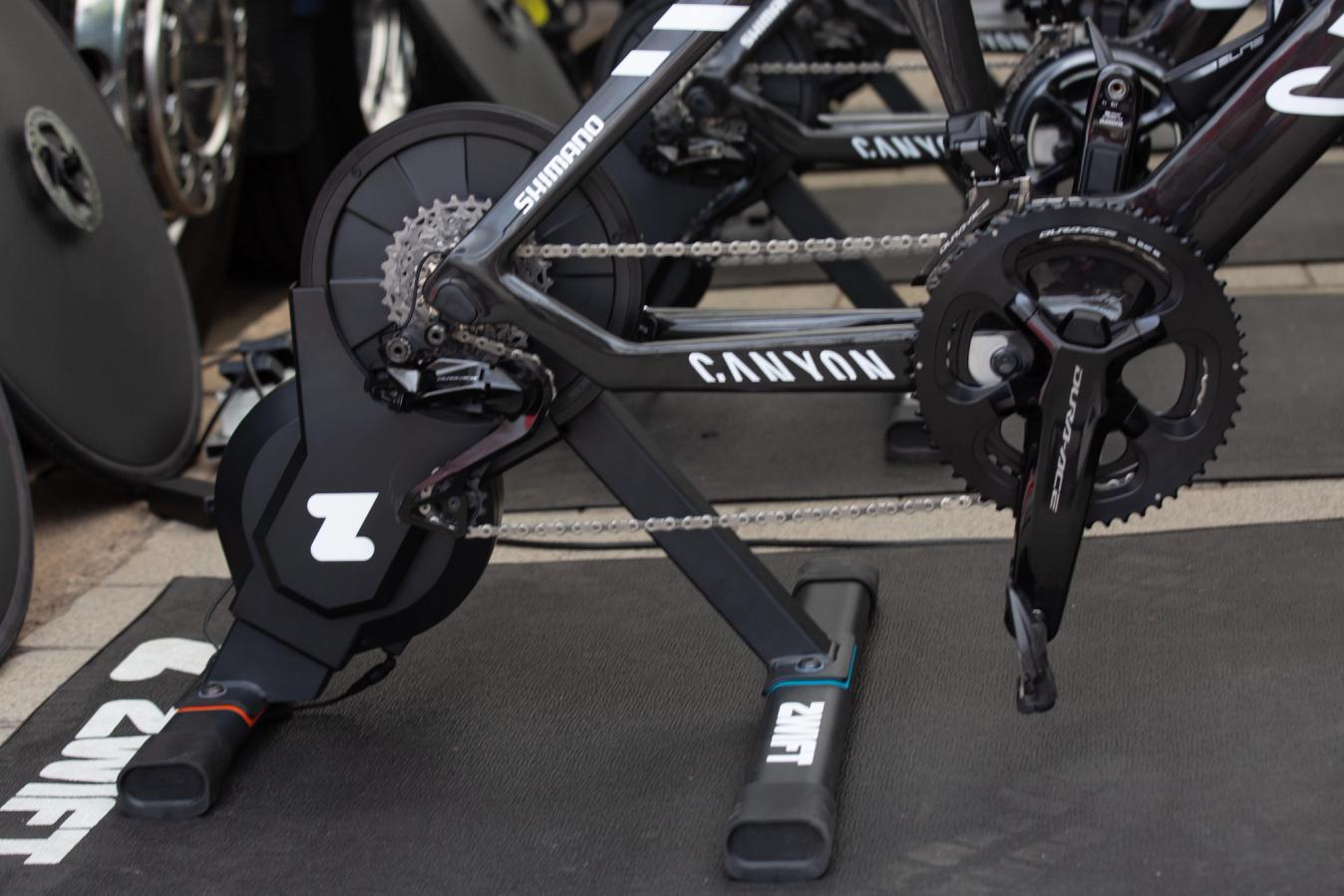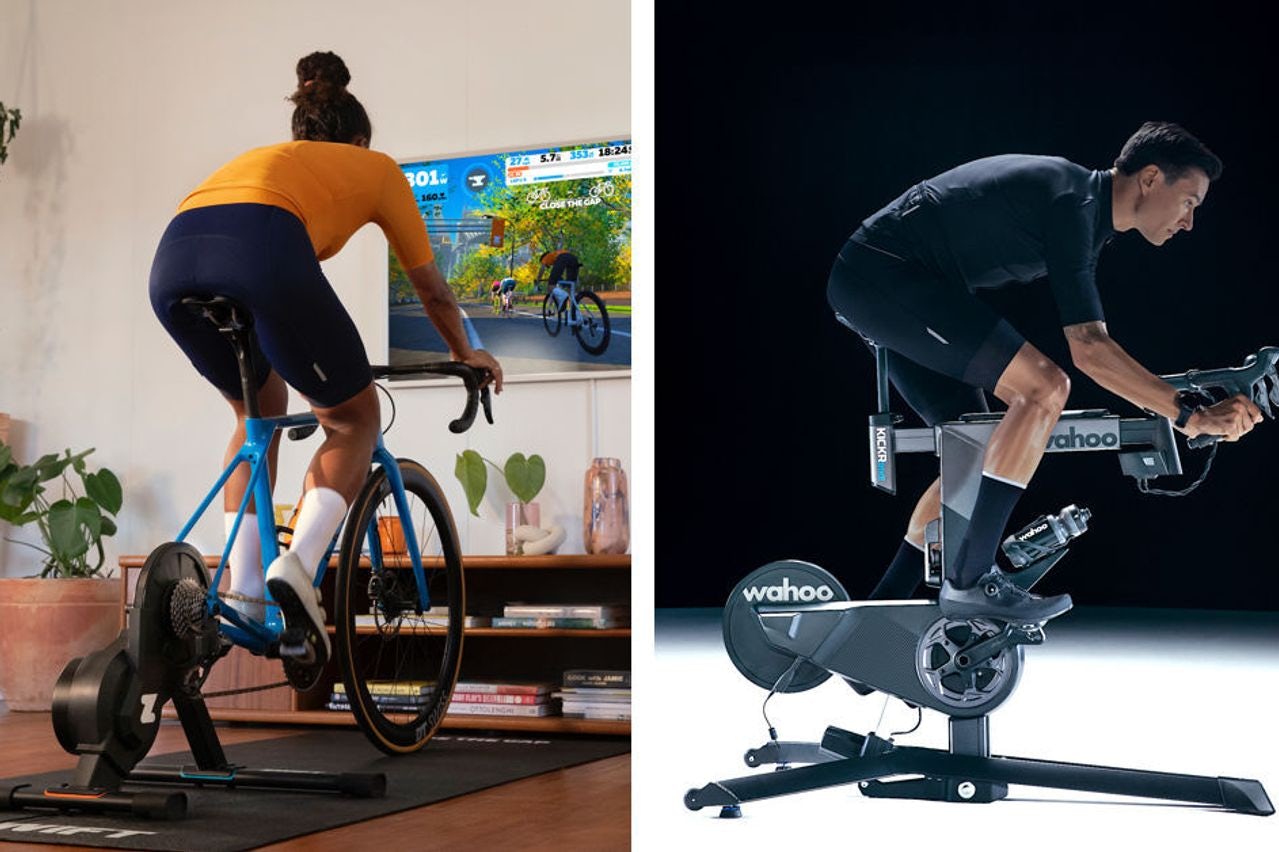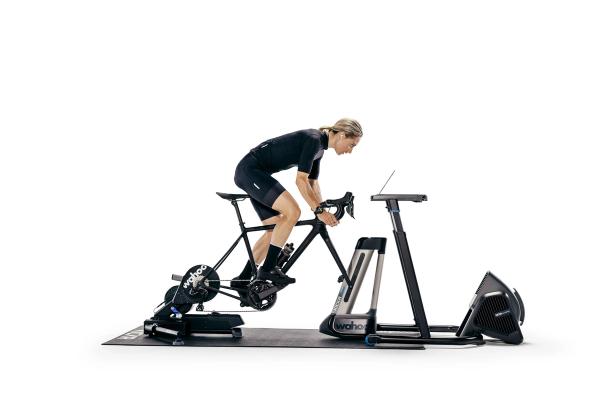Turbo trainer vs exercise bike: Which is best for indoor cycling?
To perfect your indoor cycling set-up, you’ll need the right equipment. Here’s how to choose between a turbo trainer and an exercise/static bike
Tom Hallam-Gravells
Online Production Editor
© GCN
Should you choose a turbo trainer or an exercise/static bike?
Indoor cycling used to be boring. It was a matter of sticking some music on and spinning away, with little else to keep a rider engaged or entertained.
Things have drastically changed in the last 10 years and there are now numerous indoor training apps available for cyclists from brands like Zwift and Wahoo that allow you to do everything from exploring virtual worlds to replicating the training schedules of the pros.
If you want to take advantage of these endless indoor training opportunities, you’ll need the correct set-up. This means using either a turbo trainer or an exercise/static bike, but which is the best option?
Here’s a complete guide to turbo trainers and exercise/static bikes.
What is a turbo trainer?
Turbo trainers are static devices that an outdoor bike attaches to. They create resistance as a rider pedals in two different ways.
Wheel-on turbo trainers
Wheel-on turbo trainers clamp the thru axle or skewer of the rear wheel to secure a bike in place. The rear wheel sits on a roller or drum which is used to generate resistance. This roller can usually be fine-tuned using a dial to adjust how tightly it presses against the wheel.
Generally, wheel-on turbo trainers sit at the entry-level to mid-range of the market and don’t benefit from the same high-level features as a direct-drive turbo trainer.
Direct-drive turbo trainers

© GCN
The Zwift Hub direct-drive turbo trainer
A direct-drive turbo trainer replaces the rear wheel of a bike. Once the wheel is removed, the rear drop-outs fit neatly onto the trainer and are secured in place using a thru axle or quick release skewer. The chain is placed around an in-built cassette - these are usually included with the trainer but sometimes have to be bought separately - which is used to generate the resistance.
As there’s no contact between a tyre and a drum, direct-drive turbo trainers tend to be quieter. For most brands, they’re also at the more premium end of the scale, packing in the best features including more accurate power data, a greater range of resistance and ‘smart’ capabilities.
What is a smart trainer?
To take full advantage of apps like Zwift or Wahoo SYSTM, it’s best to use a ‘smart’ turbo trainer.
Once connected to an app, ‘smart’ trainers can automatically alter the resistance you feel when riding. This is great when you’re riding in virtual worlds or competing in a Zwift race as the trainer will simulate the virtual terrain you’re riding. For example, if you’re on a climb, the resistance will simulate the specific gradient. Then when you’re on a descent, the resistance lowers.

© GCN
'Smart' trainers interact with apps like Zwift to automatically alter the resistance
Even if you’re following a simple workout, a ‘smart’ trainer can be really helpful as it’ll match the resistance level to your power target, so all you have to think about is pedalling.
When using an ordinary trainer, the resistance has to be altered manually by the rider, resulting in a less immersive experience.
Smart trainer vs 'dumb trainer' - which is best?
Indoor cycling apps have developed at a rapid rate and turbo training is a completely different activity to what it was ten years ago. Through apps like Zwift, it’s now possible to explore virtual worlds, head out on group rides, race and challenge yourself on the world’s best climbs, all from the comfort of your home.
To fully maximise and immerse yourself in these apps, a smart trainer is a must, as it will alter the resistance to simulate the virtual worlds you’re riding in. The alternative is a ‘dumb’ trainer.
These can’t communicate directly with apps and don’t provide power data. There are ways around this by using a speed sensor on the rear wheel to transmit your speed data to Zwift. The app will then convert this to an estimated power, although it won’t be as accurate as the power data for a smart trainer. It’s also less immersive as the app can’t alter the resistance to simulate the world.
What is an exercise/static bike?
If you want a more permanent solution that doesn’t include attaching and removing a bike to a trainer, then an exercise/static bike may be the way to go.
These have been around for decades and can lay claim to being the original form of indoor training. Traditionally they were fairly basic, with a dial that could change the resistance, while only providing simple data like RPM and the workout duration.
While these are still a viable option, many are now more advanced, packing in plenty of features.
At one end of the spectrum there are spin bikes. Peloton is the best-known brand in this sphere, although other brands have similar offerings. Peloton has its own training app which users can log onto to join training classes as well as access a range of off-bike activities too. It’s become a popular option for those who aren’t necessarily as focussed solely on cycling, but on improving their fitness in general.

© GCN
Wahoo's Kickr Bike Shift is a 'smart' trainer
For those who are solely focussed on cycling, there are ‘smart’ indoor cycling bikes. These function exactly the same as ‘smart’ turbo trainers, interacting with apps to automatically change the resistance. They also tend to have high levels of power accuracy and can simulate a wide range of power.
As well as a resistance unit, ‘smart’ exercise/static bikes regularly have motors so that you can freewheel down virtual descents and they’re set-up like a normal bike to simulate that outdoor riding feel.
Benefits of turbo trainers vs exercise bikes
Turbo trainers are more convenient for temporary indoor cycling set-ups
For many riders, turbo training is a seasonal pastime, reserved for the colder and often wetter autumn and winter months in the northern hemisphere. Over the summer months a trainer will lie dormant or only be used infrequently. For anyone who follows this indoor cycling pattern, a turbo trainer’s more compact design will come in handy. They can easily be stored away ready for their next use, unlike exercise/static bikes which are much larger - you’ll need a huge cupboard if you want to keep one out of sight.

© GCN
Turbo trainers don't take up much space, making them a practical option
Train, explore and race with a smart trainer
If you opt for a ‘smart’ turbo trainer, you’ll also benefit from the highest level of features, allowing you to take advantage of the best indoor cycling apps like Zwift and Wahoo SYSTM. This opens up a whole world of indoor training opportunities, from racing to exploring vast virtual cycling worlds.
Turbo trainers are better than exercise bikes for cyclists with a budget
All of this usually comes at a lower cost compared to an exercise bike too. That cost becomes even more affordable if you opt for a non-smart trainer. If you’re not interested in the interactive element and want an easy way to spin out your legs, these are the most cost-effective solution.
When is an exercise/static bike better than a turbo trainer?
Exercise bikes: best for cyclists who want a permanent pain cave
The one downside of turbo trainers can be the faff. If you’re mixing indoor with outdoor riding, that means constantly attaching and removing your bike from the trainer. Using an exercise/static bike simplifies things as there’s no set up required, it’s just a matter of jumping on the saddle and riding.
Use Zwift, Wahoo SYSTM and more with a smart exercise bike
Top-end indoor cycling bikes also have functionally to match the top turbo trainers. Many brands, like Wahoo which recently released the Kickr Bike Shift, offer ‘smart’ indoor cycling bikes that can connect with popular apps, allowing them to change the resistance. That ‘smart’ functionality is often backed up by high levels of power accuracy and impressive power ranges.
- Read more: Which Wahoo smart trainer is best for you?
Avoid an exercise bike if cost is a barrier
Despite these features, exercise/static bikes lag behind turbo trainers in the popularity stakes for one simple reason: cost. They’re usually much more expensive than their turbo training counterparts, which is a big barrier and consideration for anyone considering them.
How to choose the right set-up for your home bike workouts?
Ultimately, the best indoor cycling set-up is the one that meets your individual needs.
If you enjoy the interactive element and want to take full advantage of the multiple apps available, a smart trainer is a must. Not everyone’s fussed about exploring virtual worlds, though, and an ordinary turbo trainer can be a great purchase for basic training needs.

© GCN
'Smart' trainers create a more interactive experience when paired with apps like Zwift
Practicality also factors into the decision process, and this is where exercise/static bikes come into the thinking. There’s no need to mess about with setting them up and, if you’ll be training indoors regularly year-round, they provide a simple solution. That solution comes at a cost, although many premium ‘smart’ turbo trainers aren’t lagging too far behind when it comes to price.
Weigh up all of these factors and then decide which option best meets your needs. Whichever option you choose, indoor cycling is a great way to keep riding, and we know you’ll have lots of fun.
And don’t forget, to perfect your turbo training set-up you’ll need the must-have accessories. Check out our guide to everything you’ll need below.
Need more indoor training advice or inspiration? GCN's ultimate guide to indoor cycling has you covered with advice and guides on everything from turbo training tech to workouts. Check it out here.








.jpg?w=600&auto=format)



